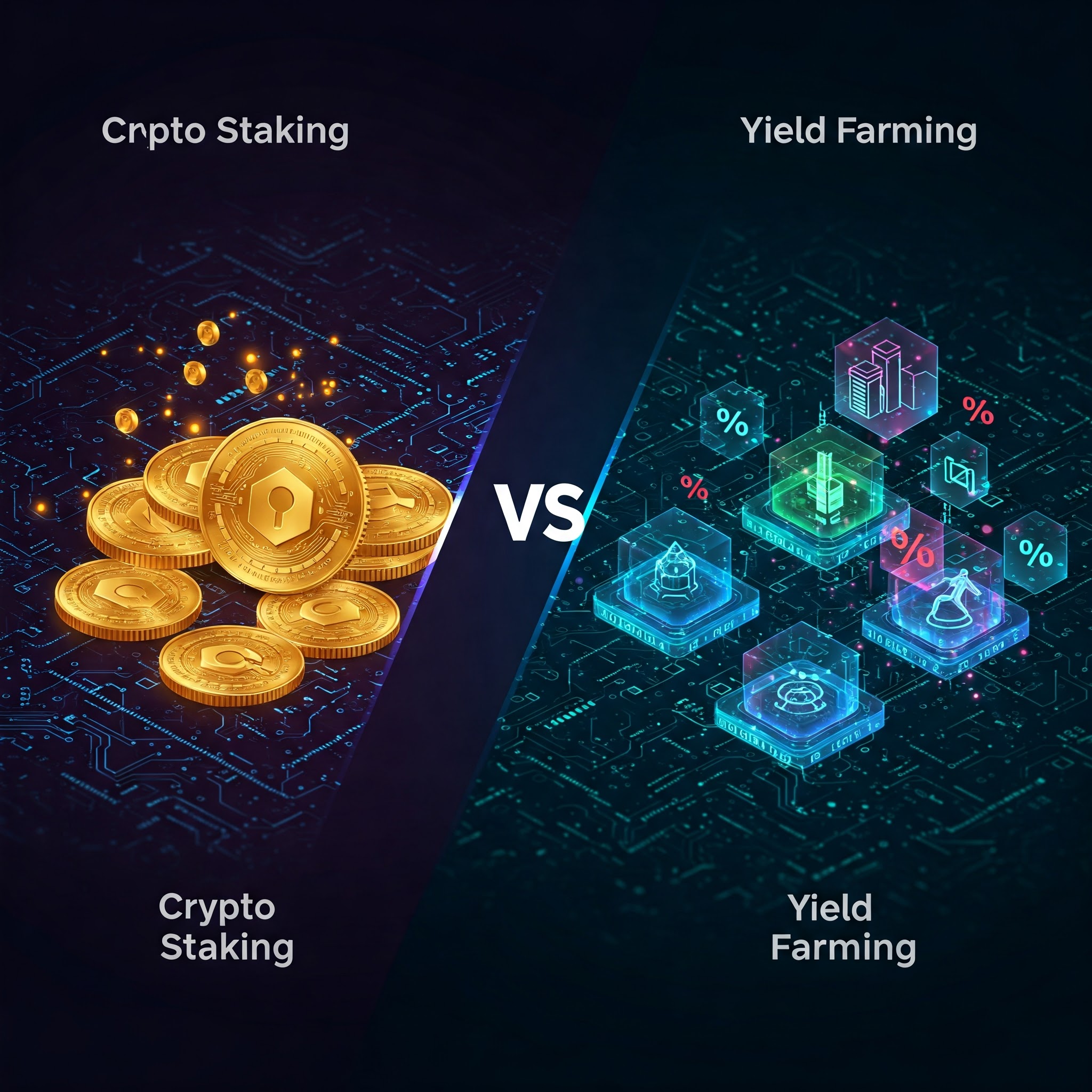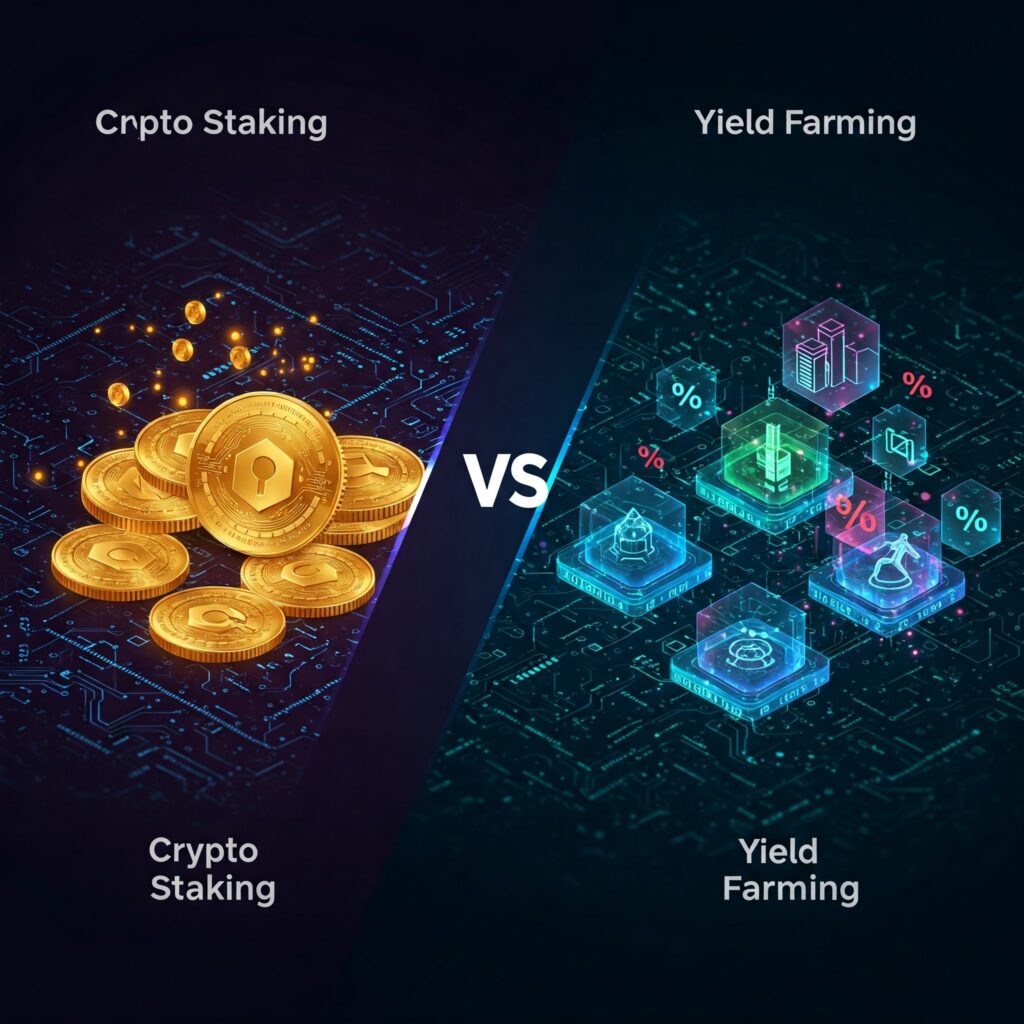Crypto Staking vs. Yield Farming: Which is the Best Passive Income Strategy?

Introduction
Cryptocurrency has opened new doors for earning passive income. Instead of just buying and holding digital assets, investors can put their crypto to work. Two of the most popular passive income strategies in the crypto world are staking and yield farming. But which one is better?
If you are a beginner, you might be confused about how staking and yield farming work, their risks, and which one suits your needs. In this guide, we will break down these two strategies in simple terms, compare their benefits, and help you choose the best option for your passive income goals.

Understanding the Topic
What is Crypto Staking?
Crypto staking involves locking up your digital assets in a blockchain network to support its operations. In return, you earn rewards in the form of additional cryptocurrency. It is commonly used in Proof-of-Stake (PoS) and its variations like Delegated Proof-of-Stake (DPoS) and Liquid Proof-of-Stake (LPoS).
How Does Staking Work?
- Choose a cryptocurrency that supports staking (e.g., Ethereum, Cardano, Solana).
- Lock up your coins in a staking wallet or on a crypto exchange.
- Participate in network validation (directly or via a validator).
- Earn rewards based on your stake amount and network rules.
What is Yield Farming?
Yield farming (also known as liquidity mining) is a way to earn passive income by providing liquidity to decentralized finance (DeFi) platforms. Investors lend their crypto to decentralized exchanges (DEXs) and receive interest or token rewards in return.
How Does Yield Farming Work?
- Deposit your crypto into a liquidity pool on platforms like Uniswap, PancakeSwap, or Aave.
- The platform uses your funds to facilitate trading.
- You earn rewards in the form of trading fees, interest, or new tokens.
Key Benefits / Advantages
Benefits of Crypto Staking
- Steady and Predictable Returns: Unlike yield farming, staking rewards are usually fixed.
- Lower Risk: Since you are not constantly moving assets, staking is generally safer.
- Supports Network Security: By staking, you contribute to the security and efficiency of the blockchain.
- Lower Fees: There are fewer transaction fees compared to frequent yield farming activities.
Benefits of Yield Farming
- Higher Potential Returns: Yield farming often offers higher returns than staking.
- Multiple Income Streams: You can earn from trading fees, governance tokens, and liquidity mining rewards.
- Flexible Withdrawals: Unlike staking, which may require a lock-in period, yield farming allows more flexibility.
- DeFi Ecosystem Growth: Yield farming helps DeFi projects thrive by increasing liquidity.
Step-by-Step Guide / How-To
How to Start Crypto Staking
- Choose a Staking Coin: Research PoS cryptocurrencies with good rewards.
- Select a Staking Platform: Use wallets like MetaMask or exchanges like Binance, Coinbase.
- Delegate or Stake Directly: Either stake solo (requires technical knowledge) or delegate to a staking pool.
- Monitor Rewards: Track your earnings and decide whether to compound or withdraw.
How to Start Yield Farming
- Choose a Yield Farming Platform: Uniswap, PancakeSwap, Curve, or Compound are popular choices.
- Provide Liquidity: Deposit your crypto in a liquidity pool.
- Stake LP Tokens: In some platforms, you receive Liquidity Provider (LP) tokens which can be staked for additional rewards.
- Harvest and Reinvest: Withdraw profits or reinvest to maximize earnings.
Common Problems & Solutions
Problems with Staking & Solutions
- Long Lock-Up Periods → Choose flexible staking options.
- Low Rewards Compared to Yield Farming → Research high-yield staking projects.
- Slashing Risks (penalty for validators’ bad behavior) → Stake with a trusted validator.
Problems with Yield Farming & Solutions
- Impermanent Loss → Use stablecoin pairs to reduce volatility.
- High Gas Fees → Opt for Layer 2 solutions or lower-fee blockchains.
- Scams & Rug Pulls → Invest only in audited and reputable projects.
Future Trends / What’s Next?
- Ethereum 2.0 Staking: More investors are moving towards staking as Ethereum transitions to PoS.
- Automated Yield Farming: New platforms are developing AI-driven strategies for yield optimization.
- Interoperability: Cross-chain DeFi projects are making staking and yield farming more efficient.
- Regulation & Security: Governments are considering frameworks for DeFi and staking investments.
Conclusion & Final Thoughts
Both staking and yield farming offer great passive income opportunities, but they cater to different risk appetites and investment styles.
- Choose staking if you prefer stability and long-term gains.
- Choose yield farming if you seek higher returns and can manage risks.
No matter which strategy you choose, always do your research, diversify your investments, and stay updated with the latest trends.
Which strategy do you prefer? Share your thoughts in the comments below!
FAQ
1. Is staking better than yield farming?
Staking is better for long-term stability, while yield farming provides higher but riskier returns.
2. How much can I earn from staking?
Returns vary by blockchain, but typically range between 5-15% annually.
3. Can I lose money in yield farming?
Yes, due to impermanent loss, high fees, or rug pulls on unsafe platforms.
4. What is the best platform for staking?
Binance, Coinbase, and dedicated wallets like MetaMask and Trust Wallet offer good staking options.
5. What is the best yield farming strategy?
Providing liquidity to stablecoin pairs or using automated farming platforms can reduce risk.
SEO Tags
#CryptoStaking #YieldFarming #PassiveIncomeCrypto #DeFi #StakingVsFarming #CryptoInvesting #BlockchainRewards #EthereumStaking #BitcoinPassiveIncome